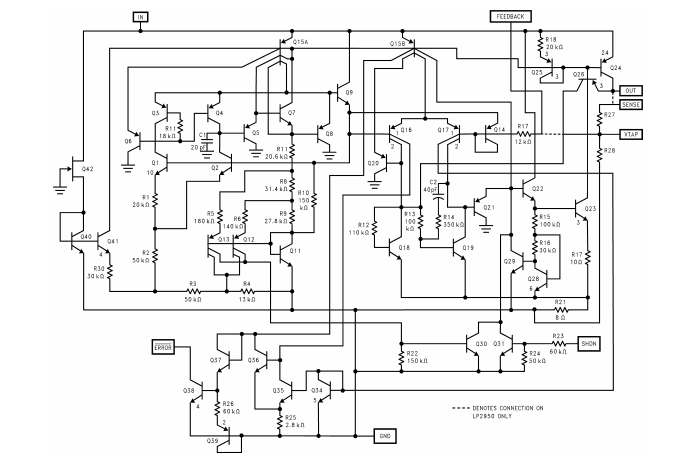
The LP2950-N and LP2951-N are micro-power regulators with very low static current (typical 75µA) and very low step-down (typical 40 mV light load and 380 mV at 100 mA). They are ideal for use in battery-powered systems. In addition, the static current of the device increases only slightly at drop-out, extending battery life.
LP2950-N Functional Block Diagram

LP2951-N Functional Block Diagram

The careful design of LP2950-N/LP2951-N minimizes the contribution of the error budget. This includes a tight initial tolerance (typical 0.5%), very good load and line adjustment (typical 0.05%) and a very low output voltage temperature coefficient, making the part usable as a low-power voltage reference. One of these features is the error flag output, which warns of a low output voltage, usually due to the battery at input. It may be used for power-on reset.
The second feature is a logic-compatible off input that allows the regulator to be switched on and off. In addition, the part can be 5-V, 3-V or 3.3V output (depending on the version), or programmed from 1.24V to 29V via an external pair of resistors. The LP2950-N is available in a surface-mount TO252 package and a popular 3-pin TO-92 package that is compatible with older 5-V voltage regulator pins. The 8-pin LP2951-N is available in plastic, ceramic dual inline, WSON, or metal can packaging, and provides additional system features.
The LP2950-N and LP2951-N are linear voltage regulators that operate at inputs between 2.3V and 30V and regulate voltages between 1.24V and 29V with an accuracy of 0.5% and a maximum output current of 160 mA. Efficiency is defined by the ratio of the output voltage to the input voltage, because LP2950-N and LP2951-N are a linear voltage regulator. To achieve high efficiency, the depressurization (VIN-VOUT) must be as small as possible, so a very low depressurization LDO is required. Successful implementation of LDO in your application depends on your application requirements. If the requirements are only input and output voltages, compliance specifications (such as internal power consumption or stability) must be verified to ensure a reliable design. If timing, startup, noise, PSRR, or any other transient specification is required, the design becomes more challenging.
Schematic Diagram
